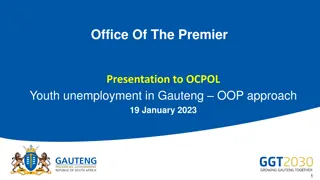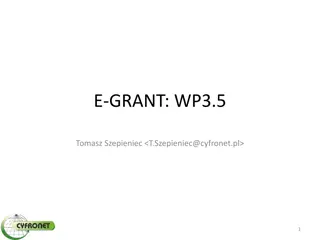NPO Funding and Budget Allocation Presentation Highlights in Gauteng DSD
This presentation focuses on the NPO funding process, budget allocation outcomes for the 2022/23 financial year, and the NPI budget and expenditure as of October 2022. It includes details on the overall NPO financial monitoring outcomes, funding preparations for the upcoming financial year, and conditions for funding in the next fiscal year. The document also covers the procedures for NPO funding, key resolutions affecting budget allocation, and expenditure breakdowns for various programs under social welfare services in Gauteng DSD.
Download Presentation

Please find below an Image/Link to download the presentation.
The content on the website is provided AS IS for your information and personal use only. It may not be sold, licensed, or shared on other websites without obtaining consent from the author. Download presentation by click this link. If you encounter any issues during the download, it is possible that the publisher has removed the file from their server.
E N D
Presentation Transcript
GAUTENG DSD SOCIAL DEVELOPMENT PORTFOLIO COMMITTTEE NPO FUNDING MODEL 28 October 2022 1
PURPOSE OF THE PRESENTATION 1. 2. NPO Funding Process; Overall NPO budget allocation and expenditure for 2022/23 FY; Departmental budget distribution NPO vs Dpt 7-year review; Overall NPO financial monitoring outcome 2020/21 FY; Monitoring plan for the current FY; Funding preparations for coming FY - 2023/24; Conditions for funding in the coming financial year; Implications to indicators and targets (2023/24 APP); 3. 4. 5. 6. 7. 8. 2
NPO FUNDING PROCESS 1 3 5 Request for Proposal Sept/Oct Budget Approval & Allocation Jan/Feb In-year monitoring & management Quarterly NPO programme and financial monitoring Issue the advert for NPO to submit the funding applications NPI budget committee and HOD to make final approval & allocation 2 4 Paneling & recommendations Oct - Dec Contracting & 1st payments March & April Regional & provincial assessment of funding applications Signing of service level agreement (SLA) and releasing of 1st payment in Aprl
NPI BUDGET ALLOCATION OUTCOME 2022/23 FY 1. Resolutions of the Cabinet Lekgotla held on 25 November 2022: Focus and upscaling of war on poverty programmes; 2. The Department will implement the 3% inflationary increments across all programmes; 3. Beneficiary expansion for existing organisations were limited to APP & Deliverology programmes; 4. Funding of priority programmes such as Gender Based Violence (GBV) programmes; 5. No consideration for vehicles or equipment; Once off allocations were considered in the previous financial year utilising the savings from 2021/22 FY; 4
NPI BUDGET & EXPENDITURE AS AT 04 October 2022 Programme SOCIAL WELFARE SERVICES Sub_Programme CARE & SERVICES TO OLDER PERSONS SERVICES TO PERSONS WITH DISAB HIV AND AIDS Current 296 823 000 137 320 395 159 502 605 143 824 000 61 337 018 443 036 000 215 392 070 227 643 930 883 683 000 414 049 483 469 633 517 260 930 000 118 572 446 142 357 554 221 002 000 104 086 782 116 915 218 90 786 000 34 220 822 572 718 000 256 880 050 315 837 950 27 240 000 11 379 106 159 414 000 71 923 768 323 159 000 157 184 349 165 974 651 509 813 000 240 487 223 269 325 777 248 556 000 125 697 084 122 858 916 18 520 000 11 170 594 7 580 000 16 412 346 274 656 000 153 280 024 121 375 976 Expenditure Available % Spent 46% 43% 49% 47% 45% 47% 38% 45% 42% 45% 49% 47% 51% 60% 217% 56% 82 486 982 SOCIAL WELFARE SERVICES Total CHILDREN AND FAMILIES CARE & SERVICES TO FAMILIES CHILD AND YOUTH CARE CENTRES COMM BASED CARE SER FOR CHILDREN 56 565 178 CHILDREN AND FAMILIES Total RESTORATIVE SERVICES CRIME PREVENTION & SUPPORT VICTIM EMPOWERMENT SUBST ABUSE,PREV&REHAB 15 860 894 87 490 232 RESTORATIVE SERVICES Total DEVELOPMENT & RESEARCH POVERTY ALLEV&SUSTN LIVELIHOODS YOUTH DEVELOPMENT WOMAN DEVELOPMENT 7 349 406 -8 832 346 DEVELOPMENT & RESEARCH Total Grand Total 2 240 870 0001 064 696 7811 176 173 219 48% Budget allocation is distributed as follows: 1. Social welfare services - 39,4% 2. Children and families 25.6% 3. Restorative services 22,8% 4. Development and Research 12,2% 5
DEPARTMENTAL BUDGET DISTRIBUTION - DPT vs NPOs (7 YEARS) 1. The size and scope of NPO sector has grown significantly since the 1990s; 2. According to the recent data from National Department of Social development, there are 258 827 registered NPOs and Gauteng has 81 996 registered NPOs; 3. Of the registered NPOs, 27 117 are registered to provide social welfare services in Gauteng; 4. The Department of Social Development in Gauteng funded approximately 3 402 during the 2021/2022 FY and the number has reduced to around 2,000 following the migration of ECDs to Department of Basic Education. FINANCIAL YEAR DSD BUDGET TRANSFERS TO NPOS % TO NPOS 2016/2017 2017/2018 2018/2019 2019/2020 2020/2021 2021/2022 2022/2023 R4,271,602 R4,586,319 R4,661,496 R5,442,951 R5,887,349 R6,148,557 R5,537,037 R2,249,623 R2,452,366 R1,935,907 R2,277,987 R2,571,152 R2,783,547 R2,240,870 53% 53% 42% 43% 41% 44% 40%
OVERALL NPO FINANCIAL MONITORING OUTCOME 2021/22 FINANCIAL YEAR High Risk Medium Risk Low RiskGrand Region High Risk Medium Risk Low Risk Grand Total Provision Type Total Ekurhuleni JHB Provincial Sedibeng Tshwane West Rand Grand Total 8% 6% 24% 19% 3% 3% 8% 23% 40% 46% 32% 19% 12% 28% 69% 54% 29% 49% 78% 84% 65% 100% 100% 100% 100% 100% 100% 100% 100 - Treatment and Prevention of Substa 101 - Services to people with disabiliti 102 - Services to Older Persons 103 - Crime Prevention, Rehabilitation a 104 - Place of Care 104 - Services to Children 3% 23% 73% 100% 11% 22% 67% 100% 8% 28% 64% 100% 6% 10% 4% 44% 33% 19% 50% 57% 77% 100% 100% 100% High Risk 9% 11% 14% 12% 16% 14% 7% Medium Risk 30% 25% 27% 25% 17% 12% 14% Low Risk 60% 64% 59% 63% 67% 74% 80% Grand Total 100% 100% 100% 100% 100% 100% 100% Monitoring Pillar or Indicator 105 - Victim Empowerment 5% 15% 79% 100% Governance Outcome Beneficiary Outcome Personnel Expenditure Outcome Prog & Admin Exp Outcome Support Docs Outcome Cash Withdrawals Outcome Unspent & Deviations Outcome 106 - Services to Families 107 - HIV/AIDS 108 - Sustainable Livelihoods 2% 4% 7% 12% 21% 33% 86% 74% 60% 100% 100% 100% Grand Total 8% 28% 65% 100% OVERALL MONITORING OUTCOME: 1. The monitoring pillar with most high risk outcomes is supporting docs at 16% followed by cash withdrawals & personnel expenditure at 14%; 2. Medium risk outcome - Governance, Beneficiary, Personnel and Prog & Admin Outcomes are above 20%; 3. The programme with most high risk NPOs is People with Disabilities and ECDs as both are above 10%; 4. Provincial is leading by having the most high risk NPOs at 24% followed by Sedibeng region at 19%; 5. Overall, 40% of the NPO population needs attention and improvement we should strive for 100% low risk; 7
OVERALL MONITORING PLAN FOR 2022/23 FINANCIAL YEAR KEY ISSUES MITIGATING MEASURES 1. Detection a) Implementation of integrated monitoring in the 2022/23 financial year; b) To conduct financial monitoring every quarter; 2. Corrective Action a) b) Assess the responses from the NPO for reasonableness and plan of action; No response will regarded as being in agreement with the findings Continue to issue written letter on each monitoring outcome 3. Implementation of Corrective Action a) Monitor positive progress in correcting the identified weakness or adverse finding (comparative analysis from Q1 to Q4); b) Failure to implement corrective action, recommend for withholding of quarterly subsidy to the regional task team; 4. Punitive Action a) Recommendation of interim administration to avoid termination of SLA and in the interest of beneficiaries; b) Recover any funds misused or lost due to mismanagement of funds; 5. Criminal Action a) Criminal action will instituted if there is indication or suspicion of fraudulent activities; 8
NPO FUNDING PREPARATION FOR 2023/24 FY Objective Timeframe 1. Call for Proposal Adverts with DSD funding requirements and specifications Will be in line with DSD institutional realignment project Closing date for submission is 31 Oct 2022. 2. Analysis of business plans and panels Oct 2022 to Mid-Jan 2023 3. NPO Budget Approvals Early to Mid-February 2023 4. SLA signing by approved NPOs Mid-Feb to Mid-March 2023 5. Capturing of SLAs and release of 1st Quarter payment April 2023 9
FUNDING CONDITIONS FOR 2023/2024 FINANCIAL YEAR (FY) 1. Funding will not be historical and general, but rather informed by current Priorities of the Department (Program Priorities & Service Area/Geographic Priorities) 2. New NPOs for 2023/24 will only be considered on condition that their programmes are aligned to Department s identified needs and/or geographic area of need e.g. GBV&F, War on Poverty Initiatives, etc. 3. No adoption and new foster care services will be funded for NPOs in the 2023/24 FY No new posts (Social Workers, Social Auxiliary Workers, etc.) will be funded for the 2023/24 FY (except on identified priority programs that may require such skills) 4. Non-compliant NPOs will NOT be considered for funding (mainly based on 2021/22 & 2022/23 Financial Years M & E and Audit Outcomes or gross violation of SLA). a) Non-compliance will include but not limited to the following areas:- b) Non-compliance to Municipal Requirements/Bylaws (Environmental Health Certificate) c) Non-compliance to the NPO Act d) Non-compliance to PFMA provisions (incl material breach to SLA conditions) e) Non-compliance to Programme Legislation f) Dysfunctional, non-performing NPOs (incl mismanagement of funds) in terms of the SLA 10
IMPLICATION ON INDICATORS AND TARGETS 1. Indicators previously allocated only to NPOs will now be shared between Government & NPOs (with Government assuming more targets on identified service priority areas only) 2. Indicators that were previously allocated to Government and NPOs will now be allocated to Government (on identified service priority areas only) 3. On Indicators that are shared between Government and NPOs, more targets will be allocated to Government (on identified service priority areas only 4. The Department reserves the right not to consider service providers/programs that are not within targeted priority areas (deprived wards) & not within Department s priority programs as per identified needs. 11
CONCLUSION Thank You 12























